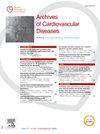Cardiovascular risk factors have an impact on the biology of pericytes
IF 2.3
3区 医学
Q2 CARDIAC & CARDIOVASCULAR SYSTEMS
引用次数: 0
Abstract
Introduction
Pericytes are critical for capillary health and function; however, whether and how they may contribute to the pathophysiology of cardiovascular diseases is poorly known. Notably, while the detrimental effects of cardiovascular risk factors on endothelial cells have been extensively studied, little is known about their impact on the biology of pericytes.
Objective
Our aim was to investigate pericyte homeostasis in the heart and brain of adult mice, after they have been exposed to type 2 diabetes or depleted by 50%.
Method
In vivo, to deplete pericytes, we used Pdgfrb-Cre/ERT2; Rosa-DTA mice in which diphtheria toxin expression is specifically induced in mural cells after tamoxifen injections. Type 2 diabetes was induced in C57BL6/J mice by a high fat diet (HFD; 60% of fat) regimen combined with low dose-streptozotocin (STZ) injections. In vitro experiments were performed on primary cultured mouse cardiac pericytes isolated from 7–14 days-old pups.
Results
In diabetes, cardiac pericyte density is reduced by 20% in C57BL6/J mice, suggesting compromised pericyte survival or renewal/proliferation is compromised by diabetes. To investigate whether hyperlipidemia and/or hyperglycemia affect these processes, we conducted in vitro and in vivo assays using cultured cardiac pericytes and DTA mice. We first characterized pericyte renewal in normal conditions by depleting 50% of pericytes in mice. Pericyte regeneration in the heart starts on day 4 after depletion and is almost complete by day 21 (pericyte density = 91% of controls). Consistently, cell proliferation, measured by KI67 staining, was observed from day 4 to day 14 post-depletion. Interestingly, pericyte renewal kinetic seems to be organ-specific: brain pericyte regeneration is slower (71% of controls after 28 days). To test the effects of hyperlipidemia and hyperglycemia on proliferation, mice were fed a high-fat diet or treated with STZ before pericyte depletion. Neither condition impaired pericyte proliferation. In vitro, glucose, free fatty acids, or LDL did not affect BrdU incorporation in cultured pericytes. However, hyperlipidemia may reduce pericyte survival, as free fatty acids, notably palmitate and oleate, significantly increased necrosis in vitro.
Conclusion
This study indicates that pericytes can undergo extensive remodeling after a stress in adults. Cardiovascular risk factors, such as obesity and diabetes, may impair pericyte survival in the heart suggesting that these cells, known to be critical for microvascular integrity, could contribute to the onset of cardiac diseases.
心血管危险因素对周细胞的生物学有影响
周细胞对毛细血管的健康和功能至关重要;然而,它们是否以及如何参与心血管疾病的病理生理尚不清楚。值得注意的是,虽然心血管危险因素对内皮细胞的有害影响已被广泛研究,但对其对周细胞生物学的影响知之甚少。我们的目的是研究暴露于2型糖尿病或消耗50%后成年小鼠心脏和大脑的周细胞稳态。方法在体内,我们使用Pdgfrb-Cre/ERT2;他莫昔芬注射后,在壁细胞中特异性诱导白喉毒素表达的Rosa-DTA小鼠。C57BL6/J小鼠高脂饮食(HFD;60%脂肪)方案联合低剂量链脲佐菌素(STZ)注射。体外实验采用7 ~ 14日龄幼鼠心脏周细胞进行原代培养。结果糖尿病C57BL6/J小鼠心脏周细胞密度降低20%,表明糖尿病损害了周细胞存活或更新/增殖。为了研究高脂血症和/或高血糖是否影响这些过程,我们使用培养的心脏周细胞和DTA小鼠进行了体外和体内实验。我们首先通过消耗小鼠50%的周细胞来表征正常情况下的周细胞更新。心脏周细胞再生开始于衰竭后第4天,到第21天几乎完成(周细胞密度=对照组的91%)。同样,KI67染色观察到细胞增殖,从耗竭后第4天到第14天。有趣的是,周细胞更新动力学似乎是器官特异性的:脑周细胞再生较慢(28天后为对照组的71%)。为了测试高脂血症和高血糖症对细胞增殖的影响,在周细胞消耗前,给小鼠喂高脂肪饮食或用STZ治疗。两种情况均未损害周细胞增殖。在体外,葡萄糖、游离脂肪酸或LDL不影响BrdU在培养周细胞中的掺入。然而,高脂血症可能降低周细胞存活率,因为游离脂肪酸,特别是棕榈酸和油酸,显著增加体外坏死。结论成人应激后周细胞可发生广泛的重塑。心血管风险因素,如肥胖和糖尿病,可能会损害心脏周细胞的存活,这表明这些已知对微血管完整性至关重要的细胞可能会导致心脏病的发生。
本文章由计算机程序翻译,如有差异,请以英文原文为准。
求助全文
约1分钟内获得全文
求助全文
来源期刊

Archives of Cardiovascular Diseases
医学-心血管系统
CiteScore
4.40
自引率
6.70%
发文量
87
审稿时长
34 days
期刊介绍:
The Journal publishes original peer-reviewed clinical and research articles, epidemiological studies, new methodological clinical approaches, review articles and editorials. Topics covered include coronary artery and valve diseases, interventional and pediatric cardiology, cardiovascular surgery, cardiomyopathy and heart failure, arrhythmias and stimulation, cardiovascular imaging, vascular medicine and hypertension, epidemiology and risk factors, and large multicenter studies. Archives of Cardiovascular Diseases also publishes abstracts of papers presented at the annual sessions of the Journées Européennes de la Société Française de Cardiologie and the guidelines edited by the French Society of Cardiology.
 求助内容:
求助内容: 应助结果提醒方式:
应助结果提醒方式:


